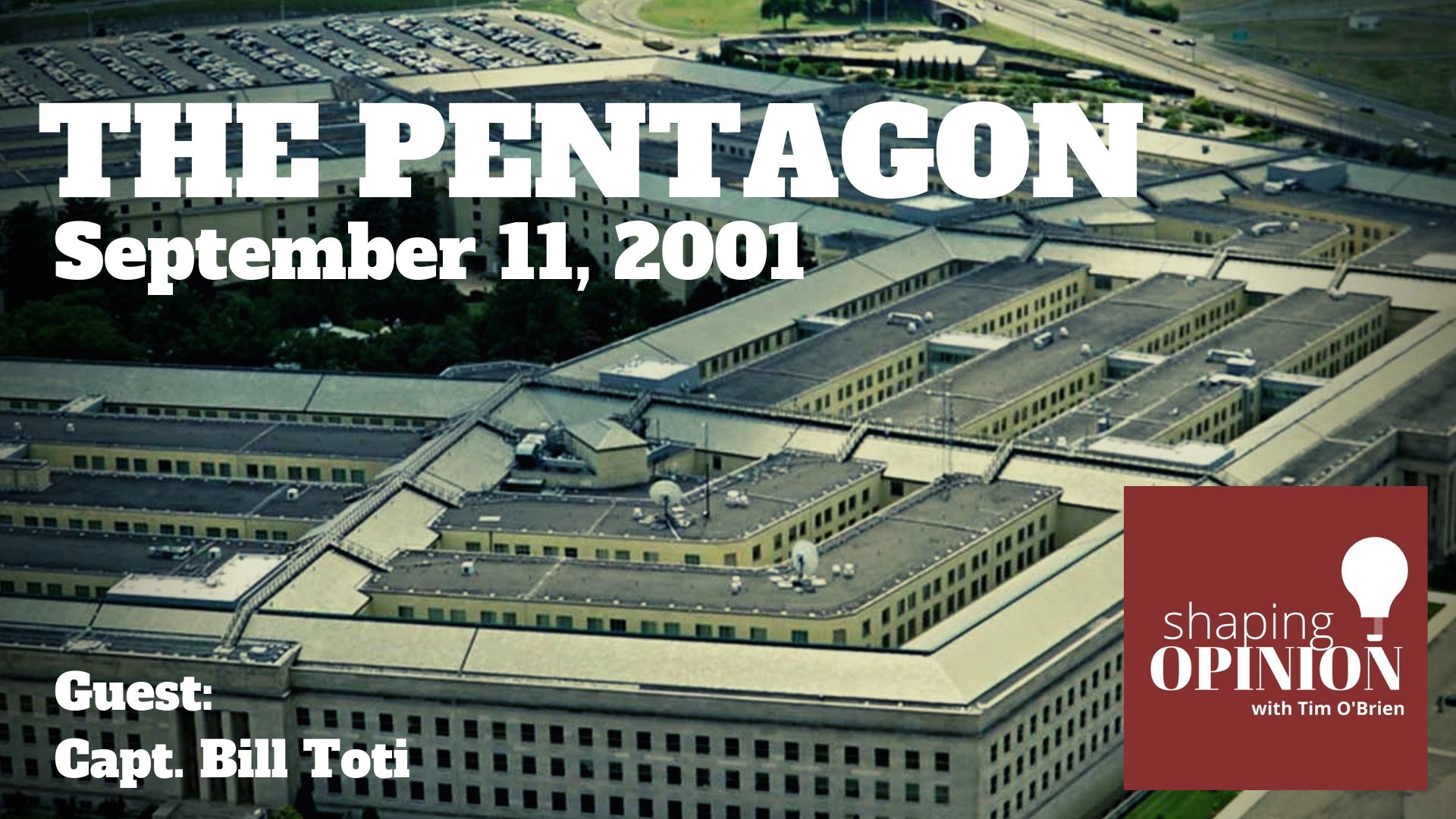Captain Bill Toti, a retired Naval officer, joins Tim to discuss his firsthand experiences from the Pentagon on September 11, 2001. Bill remembers the attack on the Pentagon moment for moment, and what he did in the immediate aftermath and throughout the recovery. One thing we talk about is how the Pentagon’s story may be the least known in the conversation on 9/11.

On September 11th, 2001, 19 terrorists from the extremist group al-Qaida hijacked four commercial aircraft and used those planes to carry out suicide attacks against the World Trade Center in New York, the Pentagon in Washington, D.C., and what appears to be a failed attempt to target another Washington, D.C. target.
At 8:45 a.m. on that a clear day, American Airlines Flight 11 crashed into the north tower of the World Trade Center in New York. Eighteen minutes later, a second passenger jet – United Airlines Flight 175 – flew into the South Tower of the World Trade Center.
At 9:45 a.m., American Flight 77 would circle over Washington, D.C. before crashing into the west side of the Pentagon, ripping through the outer three of the Pentagon’s four, heavily reinforced and massive rings.
At 10 minutes after 10 that morning, United Airlines Flight 93 crashed into an empty field in Shanksville, Pennsylvania, after it appears the passengers on that jet foiled a terrorist attack on Washington.
At the end of the day, it was the worst terrorist attack on the United States in the country’s history. Almost 3,000 people were killed.
Millions watched events unfold on television, though most of the country’s attention was on New York, where the World Trade Center’s twin towers would collapse on live TV, and where the greatest human losses occurred.
At the Pentagon, 189 military personnel and civilians were killed, including the 64 people aboard American Flight 77.
To this day, less is known about what happened that day at the Pentagon than the stories from New York and Pennsylvania.
The Chronology of Events at the Pentagon
- That morning, five militants passed through security at Dulles International Airport at approximately 7:35 am.
- They boarded American Airlines Flight 77 that was on its way to Los Angeles, California.
- At 8:20 am, Flight 77 departed Dulles International Airport.
- The jet had 64 people on board: a crew of six plus 58 passengers, including the five terrorists.
- The last routine radio communication with American Airlines Flight 77 occurred at 8:51 am.
Investigators have guessed that between 8:51 and 8:54 that morning, somewhere over Kentucky, the terrorists took control of the plan. - The hijackers turned the jet southward, and then around 9 a.m., they turned the plane toward Washington, D.C., all the while causing confusion among air traffic control.
- The hijackers had turned off Flight 77’s transponder, causing the aircraft to become invisible to air traffic control. No one knew the course, the speed or the altitude of the jet.
- The militant pilot would not answer any radio messages.
- At 9:33 am, Flight 77 headed for the Pentagon.
- Controllers at Ronald Reagan Washington National Airport told the Secret Service Operations Center in Washington, D.C. that “an aircraft is coming at you and not talking with us.”
- At 9:37 a.m., American Airlines Flight 77 crashed into the Pentagon.
Captain Bill Toti was there and remembers what it was like that day, and in the years since, he has worked to help keep the story of the Pentagon on that day in the nation’s memory.
Links
- 9/11 ‘Inside the Pentagon’ Documentary, PBS
- The Pentagon: Local Naval Officer Details Chaos After Attack, Youngstown Vindicator
- 9/11 Pentagon, Naval History and Heritage Command
- ‘The Forgotten 9/11:’ Returning to the Pentagon 15 Years Later, NBC News
About this Episode’s Guest Captain Bill Toti

William Toti served for more than 26 years in the U.S. Navy, including tours as commander of Fleet Antisubmarine Warfare Command Norfolk, as commodore of Submarine Squadron 3, and as commanding officer of the nuclear fast attack submarine USS Indianapolis (SSN 697). He also served for more than nine years in the Pentagon, including tours as special assistant to the Vice Chief of Naval Operations, as Navy representative to the Joint Requirements Oversight Council, and as deputy director of the Navy War Plans Cell, Deep Blue.
He was on duty in the Pentagon on September 11, 2001, when American Airlines flight 77 slammed into the building. His experiences that day were captured in the 2006 Simon & Schuster book Operation Homecoming, as well as the 2016 PBS documentary “9/11: Inside the Pentagon.”
He has also served for more than 13 years as a defense industry executive, currently serving as Chief Executive of Sparton ECP.
Mr. Toti holds a bachelor’s degree in physics from the U.S. Naval Academy, a master’s degree in spacecraft systems engineering, and the pre-doctoral Electrical Engineer degree from the Naval Postgraduate School. He served as a Federal Executive Fellow at the Brookings Institution and as a Massachusetts Institute of Technology Seminar XXI Fellow in International Affairs. He has more than 30 published articles and op-ed pieces, and was the U.S. Naval Institute Author of the Year in 2001. In 2012, Toti was a member of the White House Roundtable on Military Credentialing and Information Technology in support of President Obama’s initiative to help service members receive civilian credentials and licenses.
Mr. Toti is a seven-time recipient of the Legion of Merit, a recipient of the “Wash 100” list of most influential leaders in the government contractor sector (2016), HP Executive of the Year (2013), the FedScoop 50 Industry Leadership Award (2012), and the Rear Admiral John J. Bergen Industry Award from the Navy League of the United States (2010). He is a lifetime member of the US Naval Institute and the National Eagle Scouts Association, and as an adult leader was awarded the Honor Medal by the Boy Scouts of America (2002).
He is an honorary survivor of the World War II cruiser USS Indianapolis (2005), and has been featured in several global-release documentaries, including “9/11: Inside the Pentagon” (2016 PBS), “USS Indianapolis: Live from the Deep” (2017 PBS), and “USS Indianapolis: Legacy Project” (2016, Tiny Horse Productions).




